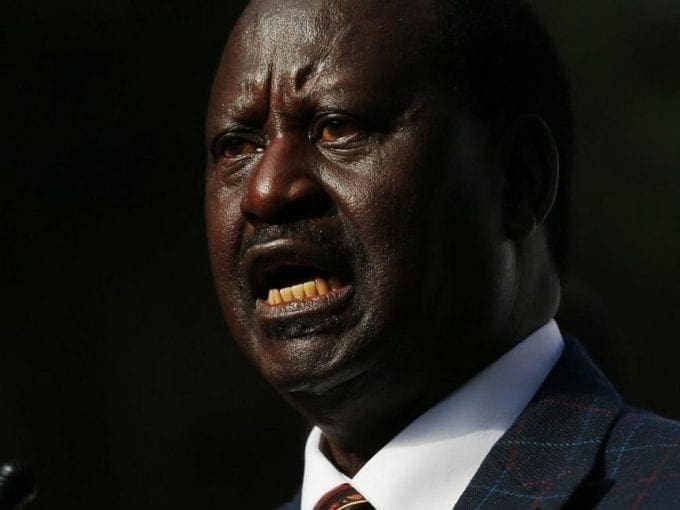Burnt by the ‘Flame of Freedom’? What really went wrong with the Odingas?
Raila Odinga’s fall at the polls last week was a tumble of tectonic proportions.
There are those who expected that he would become President, move into State House as a culmination (reward) of his family’s seven-decade-long fight to expand the democratic space in this country.
In many ways, he was fighting his father’s battles but it is apparent that there was a glass ceiling both just could not break. Jaramogi Oginga Odinga run for President in 1992 and was beaten to it by President Daniel Moi. He died a broken man two years later. Raila Odinga then took up the mantle from his father and run for the high office in 1997. He failed but formed a coalition five years later that swept Mwai Kibaki into power.
He would play a minimal role in that government and quit altogether following a massive disagreement with Kibaki. He led a rebellion against the Kibaki government, working to the defeat of the Wako Constitution Draft in 2005.In 2007, he was on the ballot again and although it was obvious that he won, he never became President. Five years later in 2013, he fell into the hands of Uhuru Kenyatta and a second time last week.
In short, the Odinga name has appeared on our presidential ballots consistently since 1992 — 25 years in a row save one, with no luck. They have been at the forefront of our national politics since the senior Odinga was first elected to the Legislative Council in 1957 — 60 years ago. Begs the question: What really went wrong with the Odingas?
METAPHYSICAL EXPLANATIONS
The consistent failure at the polls by the two Odingas has brought others to wonder whether there are any negative spiritual energy in the family. We live in a society where metaphysical evidence is constantly adduced to explain strange events. (It is, therefore, a good idea to also listen to what they have to say even if you don’t intend to go by them). This is also because this line of thinking is part of our collective social psyche as Africans, and it, therefore, falls on us to first enquire if there is any truth in it. Metaphysics and the explanation of unusual occurrences is not new, neither is it unique to us in Africa. When the Kennedys in America suffered so many tragedies in the family, some tried to explain it away as a curse collected along the way by their rather sinful patriarch, JP Kennedy Sr Others have said that JFK fell under ‘Tecumseh’s Curse’, which saw the deaths in office of all US Presidents elected every two decades starting 1840, with the close exception of Ronald Reagan, who escaped an assassin’s bullet ending the curse. Could inter-generational jinxes apply to the Odingas? Let us first examine the predictions of an Odinga Presidency.
PROPHECIES OF ODINGA
PRESIDENCY
If you told anyone that Raila would not be president in 2007, they would have highly doubted you. He was indeed headed to State House, and many had placed their bets on his presidency.
According to bloggers Anderson Ojwang and Allan Kisia, the great Luhya prophet Elijah Masinde prophesied, saying, ‘Bumwami bukhamile khunyanja’ (the leadership will come from the lake). Writing in September 2007 prior to the disastrous elections of that year, they applied the prophecy to mean an Odinga presidency. This is uncannily similar to that of the ancient Kipsigis prophet Mugeni of the Kipkenda clan, who had made an exact similar prophecy.
Historians do not normally discard such prophecies as they have the effect of altering the course of history. The great Rastafarian movement begun on the prophetic words of Marcus Garvey telling fellow Jamaicans ‘Look to Africa, when a black king shall be crowned, for the day of deliverance is at hand.’ And so in 1930, when Ras Tafari Makonnen (Haile Selassie) was crowned in Ethiopia the Rastafarian movement (faith) arose. Raila has, however, moved to the Supreme Court to lodge a petition and so we await to see the outcome. The two prophecies may still have some currency after all.
THE CURSE OF MUMIA
I came across a writer on social media who stated that there was an ‘invisible hand’ in the latest Odinga debacle, terming it ‘the Curse of Mumia’. Although he doesn’t provide any credible details, another online writer adds currency to this thought saying that Raila’s grandfather was a key member of the ancient Luhya Kingdom of Wanga led by Nabongo Mumia. He says that somewhere in the 1890s, while serving as the aide-de-camp of Mumia, he led a palace coup to depose the Nabongo. The coup failed and he was immediately expelled from the Kingdom — but not before a curse was placed upon him, saying that he and his generations would never rise to power. He then left and established himself among the Luo in Sakwa, where Odinga was born.
A quick fact-check, however, shows that this thinking holds little water. Oginga did record his lineage in his book Not yet Uhuru. He says his great great grandfather Wenwa begat Rapondi, who begat Rayila, who begat Ajuma, who begat Oginga Odinga and who in turn begat Raila Amolo. There was no evidence that any of them had served in the court of the Nabongo. He speaks of his grandfather Rayila (after whom he named his son) as being rather indigent and unable to even raise dowry for a wife and being forced to marry a widow. The Nabongo Mumia on the other hand reigned from circa 1882 through 1949. If anyone in the Odinga lineage served in that court, then it should have been Oginga’s grandfather Rayila but then it is clear according to the book that he struggled to raise his family and the lineage was long established in Luo Nyanza, far away from the Nabongo. The ‘Curse of Nabongo’ cannot, therefore, be a credible explanation of the consistent debacle at the polls.
SINS OF THE FATHER
Perhaps it was Odinga’s dalliance with socialism that cast a long political shadow over his own and his son’s political career. According to some, Raila’s campaign promise to deal with high rent in Nairobi, brought images of socialist-style control/take-over of housing or state-imposed rent restrictions.
This declaration, while popular to the restive masses, served to galvanise the middle-class, and propertied elite against his bid. Nairobi is a city with an extraordinarily vibrant real estate market with high property values and rents to match. Homes constructed through the sweat and toil of landlords, are jealously guarded through multi-generational family holdings. His call for a re-look on the rent structures was most unwelcome to this class. Other than that, the whole idea of ‘Canaan’ in his campaign had strong connotations of Utopian socialism and which only reinforced the said perceptions. In fact, the whole idea of ‘Canaan’ only served to convince many that he was every bit his father’s political son.
In every sense, therefore, the day Odinga picked up Karl Marx’s Das Kapital, was the most likely the day that he took the path to political disillusion, taking his son along with him. In a close interview in the last days of his life, author Prof H Odera Oruka gives us a rare glimpse into the ideological world of Oginga in his book Oginga Odinga: His philosophy and Beliefs. In the book, Odinga enumerates Frantz Fanon’s ideas on Marxism in Africa, while at the same time he does little to respond to the perennial accusation that he was a Marxist.
THE ILL-FATED VISIT TO MOSCOW
By the time he was espousing socialism, the world was getting into the Cold War that pitted the US and the USSR. Odinga would become one of its biggest casualties. In the years before Independence, Odinga quickly made inroads into the world of Socialism and made friends with other famous African socialists such as Kwame Nkrumah, Samora Machel and others abroad, including Mao Tsetung, Chou En Lai and Nikita Khruschev, among others. He also made connections with later converts to socialism, Milton Obote and Julius Nyerere. The rise to power of the latter duo in East Africa placed Kenya under the spotlight, and Oginga in particular. However, it was a massive mistake he made in the middle of 1964 that served him a fatal political blow. And he would never recover from it.
THE BLACKS AND THE REDS
In April 1964, Odinga travelled to Moscow and stood in Red Square as an honoured guest of the Soviet state. Episode 5 of Niall Ferguson’s historical documentary series The War of the Worlds: A New History of the 20th Century has a footage showing Oginga happily waving his flywhisk at the dais in Moscow’s Red Square to a mammoth crowd, and the passing massive military hardware. The same footage also shows him holding hands aloft with Nikita Khrushchev and Samora Machel at the same venue. This rare video (available on YouTube) could only have been made by the CIA and was probably what put him on their radar. Just two months prior, the Americans had appointed William Attwood as its Ambassador to Nairobi. Attwood, a virulent anti-Communist, went to work personally setting in motion the series of events that compounded Odinga’s problems that would eventually leave his political star severely diminished.
HOUNDED OUT OF POWER
Within two years of appearing at Moscow’s Red Square, Odinga was out of power and would never regain it in his entire life. It was clear to all that Kanu was severely divided ideologically, with some of its senior leaders having strong Socialist or Capitalist leanings. The Kanu socialists included Odinga, Pio Gama Pinto and Bildad Kaggia, among others. Pinto fell under an assassin’s bullet in a yet-to-be resolved murder, while his friend Joseph Murumbi would resign. Attwood’s hand was clearly visible in the fall of Kanu’s socialists. He worked to undermine Odinga’s position in the Kenyatta government a move that saw his eventual ouster from Kanu and his resignation from Government in April 1966. It turned out however that Attwood was the silent bogeyman in the background.
ENTER RAILA ODINGA
You can imagine what was going on in the mind of teenager Raila, who had left Kenya for East Germany in 1962 aged 17. Raila was holed up in Leipzig, closely following his father’s political debacle but could not do much. On his return to Kenya, his father’s political organisation was in total chaos. In fact, the things KPU had to endure between the day it was registered on May 23, 1966 and when it was banned on October 30, 1969 would make a voluminous book. In Sarah Elderkin’s book on Raila The Flame of Freedom enumerates the harassment his father had to endure under the hands of President Kenyatta. From the sudden recall of loans that crippled his family financially to house arrest and auctioneers sent to take over their property. Most of KPU legislators were in jail when Raila returned. His father was in house arrest. Severe political repression in the 1970s and the assumption of power of President Moi at the end of that decade, understandably left Raila with only on option — revolution to remove Kanu from power.
BURNT BY THE FLAME OF FREEDOM
Raila’s part in the failed 1982 coup is well enumerated. However, we must see that coup in terms of what it did to Kenya. Kenya would never be the same again. It lost its innocence that day and only worsened the tribal polarisation that can be observed today and which partly explains Raila’s loss in this election. In many ways, the ‘Flame of Freedom’ that Raila had lit, would burn him almost to a cinder. Raila was arrested while his uncle Peter Oloo Aringo, then the Environment Minister, was sacked by President Moi on August 10, 1982. On September 22, 1982 Raila was charged in court with treason. His foot soldiers — the Air Force coup-makers — were hanged, while he escaped by a whisker as his family’s political (and financial) fortunes took a dive for the worse. Mama Ida had to endure horrendous treatment in the hands of Moi. He served nine years in detention. However, he returned and added his voice to the clamour for pluralism. Moi had consistently fought the idea, saying it would lead to the enclavisation of the country.
WAS MOI RIGHT AFTER ALL?
Frantz Fanon once said, ‘Each generation must discover its mission, fulfill it or betray it, in relative opacity.’ Was pluralism best suited for a time and place such as this? We cannot help but wonder if Moi was right about the polarising effects of pluralism. Moi to this day still curses pluralism. Today one has to see that this nation is divided right down the middle despite what you may want to say.
While I personally do not subscribe to the idea that our elections are a ‘tribal census’, you can’t help but see those patterns clearly painted in the just concluded election. There are those who did not vote for Raila simply because of his tribe, nothing more. Did pluralism come too soon? Are we particularly well-suited for it the way we know this country? What was really in this glass ceiling? In bringing in pluralism in Kenya, was Raila the victim of his own drive to expand the democratic space in Kenya?
These are questions that must lead the debate into what really happened to the Odingas.
Source link-the-star.co.ke
Burnt by the ‘Flame of Freedom’? What really went wrong with the Odingas?










